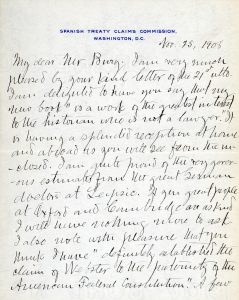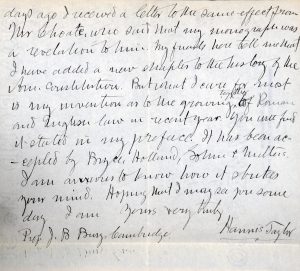Hannis Taylor’s Science of Jurisprudence: Book as Text, Book as Object, Book as Legacy
- October 12th, 2016
- by specialcollections
- in Collections, Guest Contributors, Preserved in Amber
For the next offering in our series titled “Preserved in Amber,” we feature a post by U.A. law student Hudson Cheshire on our Hannis Taylor collection. This collection consists of a copy of Taylor’s 1908 treatise The Science of Jurisprudence with two of his letters affixed to the endsheets. The letters are addressed to Cambridge history professor J.B. Bury. They seem blatantly self-promotional, but Cheshire demonstrates that they are also poignant and suggestive documents—items that transform this copy of a long-forgotten book into a unique archival object. Taylor (1851-1922) was a politician, lawyer, and prolific author associated with Mobile and Washington, D.C. We at Litera Scripta have long regarded him as an interesting and collectible writer (the subject, also, of a well-constructed biography).
Hannis Taylor’s Science of Jurisprudence: Book as Text, Book as Object, Book as Legacy
In any physical book there are multiple stories at work.
Of course, there is the text itself: the words and sentences and paragraphs through which the author communicates his ideas. But in addition to the text, the history surrounding the text also tells a story. One might think of Harper Lee’s childhood in conjunction with her novel, To Kill a Mockingbird. But every text is also influenced by other texts. Doubtless, Go Set a Watchman changed the way most readers see the stoic, justice-seeking attorney, Atticus Finch. Finally, the physical object of a book also tells a story: with time, any physical book may be dog-eared, annotated, or otherwise marked by its readers. Through these physical traces we are given glimpses of another story still. Perhaps the greatest allure of opening an old book is the chance to observe all of these different stories as they intersect and intertwine.
The subject of this blog post is a 108-year-old copy of a little-known book: The Science of Jurisprudence, by Hannis Taylor. 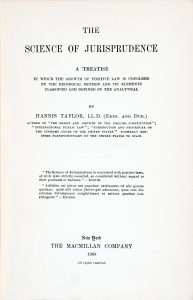 The book is noteworthy in its own right as the work of a once important Alabama resident advancing a unique theory about American history. The library’s particular copy of the book is interesting for what are pasted onto its end sheets: two shamelessly self-promotional letters from the author to a professor overseas. Perhaps the most interesting aspect of the collection, however, is what happened only months after the letters were penned.
The book is noteworthy in its own right as the work of a once important Alabama resident advancing a unique theory about American history. The library’s particular copy of the book is interesting for what are pasted onto its end sheets: two shamelessly self-promotional letters from the author to a professor overseas. Perhaps the most interesting aspect of the collection, however, is what happened only months after the letters were penned.
To say the least, there are many different stories buried in this particular old book. Perhaps the best place to begin is with the book’s author: Hannis Taylor. Though nearly forgotten in contemporary scholarship, Taylor was an important figure in his own time, not only for his published writings, but also for his influence as both a lawyer and political figure.
In a well-written biography, Alabama historian Tennant McWilliams portrays the nuances of Taylor’s character, carefully noting both his successes and failures. McWilliams stresses that Taylor never ceased to strive for fame and excellence—he was determined to make a lasting mark. As a result of this, Taylor’s contemporary anonymity may seem to cast him as a failure. Nevertheless, from a wider angle, Taylor’s life seems to represent a particular version of the American Dream. Through relentless ambition and undeniable discipline, Taylor worked his way up from a modest household into a position of national significance.
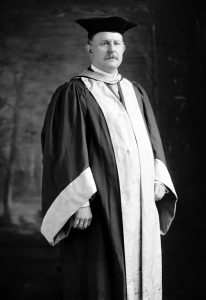
Taylor was born in North Carolina in 1851. When he was 18, Taylor’s mother contracted tuberculosis and the family moved to South Alabama, in search of a warmer climate. When his mother died, his father became unstable and Taylor was left to provide for his six siblings. Making use of his modest education, Taylor clerked for a lawyer and soon gained admission into the Alabama Bar. From there, he built an impressive resume of accomplishments. Climbing the social ladder of the Mobile elite, he befriended important political figures and was appointed by Grover Cleveland as minister to Spain in 1893. As a litigator, he argued multiple cases before the Supreme Court of the United States. As a tireless legal scholar, he published several historical treatises.
Taylor’s success is encapsulated in his proposed solution to the post-Civil War reconstruction debts under which Mobile suffered in the late 1800s. In 1878, citing arcane constitutional theory and jurisprudence, the young lawyer successfully argued for dissolving the debtor city’s charter and opening a new charter, rendering the old debts largely unreachable. As the anecdote reflects, Taylor was confident and convincing, with a penchant for obscure legal knowledge and immense faith in our legal system.
Whatever his intellectual strengths, Taylor apparently lacked political savvy. In that sense, the very position that gained Taylor national recognition (his appointment in 1893 as United States Minster to Spain) may also suggest why he never rose to greater prominence. While Taylor didn’t know Spanish or have any experience in foreign diplomacy, Grover Cleveland appointed him because he was a well-respected Southerner and “orthodox democrat.” His tenure was not the failure it might have been but Taylor floundered in his efforts to reach compromises with the Spanish Congress. Even worse, as the Cleveland administration attempted to stay out of Spanish-Cuban affairs, Taylor advocated for American intervention to secure Cuban autonomy. If Taylor’s rejection of Cleveland’s position illustrates his independence and confidence, it also shows his political ineptitude.
Still, perhaps Taylor’s greatest failure was his inability to find a truly practical application for his expansive legal knowledge. In arguing a First Amendment case before the United States Supreme Court in 1892, he put his impressive grasp of constitutional history to use. The government attorneys found his arguments to be “very edifying… [but] quite irrelevant,” a stance that recurred in the Justices’ decision.
However, if Taylor had faith in the power of obscure research, it wasn’t without basis. In addition to the success of his proposal regarding the Mobile charter, Taylor was lauded for the publication of multiple historical treatises. One such text, The Origin and Growth of the English Constitution, gained international renown for its novel insights and careful research.
Another of Taylor’s volumes, of course, is The Science of Jurisprudence (1908), the subject of this post. Though this book also left an impression overseas, it was for different reasons. (Goudy) Given Taylor’s context as a respected scholar and political thinker, the book is somewhat of an enigma. Though Taylor seemed to believe that it would secure his name in the annals of history, Science arguably served as the death knell to his scholarly career.
In The Science of Jurisprudence, Taylor advanced two ideas that seem to have been discussed more than others. First, and most generally, Taylor argued that the public law of Rome and the private law of England had come, increasingly, to dominate contemporary legal systems. (Science of Jurisprudence, xxi-xxii) However, Taylor also used the book to make a bolder assertion: that he had discovered the true “author” of the United States Constitution. (Science of Jurisprudence, 446)
In his chapter on English law in the United States, he notes that the founding fathers arrived at the Philadelphia Convention with five different “plans,” four of which proposed the novel structure for federal government that became the basis of the Constitution. After laying this groundwork, Taylor asks whether “that Wonderful invention” was miraculously revealed to a large number of people acting in isolation, or was instead the product of a single personal author. His answer, of course, is that there was a single personal author. The author was Pelatiah Webster, a Philadelphia attorney and contemporary of Madison. Taylor specifically argues that the basic tenants of federalism that Jefferson and Madison imported into the Constitution were mined directly from “A Dissertation on the Political Union and Constitution of the Thirteen United States of North America,” a pamphlet that Webster had published in 1783. (Science of Jurisprudence, 444, 446)
Beyond the claim itself, the text is particularly interesting for Taylor’s tone. In his discussion of Webster, Taylor sounds condescending (“the marvel is that historians who are supposed to have explored the sources have never [discovered the source of the constitution]”), intensely reverent (referring to Webster as “the great one” and “the great inventor”), and of course, bold (“among our nation’s builders [Webster] stands second to Washington alone”). (Science of Jurisprudence, 445-449)
When Taylor advanced these arguments, Webster was obscure but not unknown among scholars of American history. Most historians knew him as a public intellectual of the 1780s, but considered him to be unworthy of serious attention. Legal thinker Edward Corwin published a succinct critique of Taylor’s Webster theory in the Michigan Law Review in 1912, aptly titled, “The Pelatiah Webster Myth.” Corwin explains that all of the influential ideas Taylor attributes to Webster belong in one of two categories. Some of the ideas Taylor attributes to Webster (e.g. granting the federal government a tax power) were present in other writings and public thought well before Webster’s pamphlet. The other ideas that Taylor put forth (for example, Webster’s advocacy of separation of powers and checks and balances) are simply far-fetched interpretations of what Webster actually intimated in his writings. For example, Taylor claims that Webster anticipated the structure of the federal judiciary. Specifically, Taylor cites Webster’s suggestion that a “supreme authority should be vested with powers to terminate and finally decide controversies between different States…. [with] an appeal from the first instance… in causes of great moment.” Corwin correctly observes that Webster is not referring to a court system, but to congress. Furthermore, that congress would settle matters between states had already been established in the Articles of Confederation. (Corwin, “Pelatiah Webster Myth,” 622, 623) The idea was not prophetic. For that matter, it wasn’t even original.
As Corwin notes, and history has borne out, many of Taylor’s claims about Webster’s influence are unfounded. However, to suggest that Taylor simply reached faulty conclusions may be an understatement, for Corwin’s article takes aim at the shoddiness of Taylor’s research: “Mr. Taylor’s idea of history is, that while some sort of document is necessary to render it plausible, yet given your document you may construct your history to suit your fancy.” (Corwin 623) However, perhaps reasonably, Corwin also sometimes tips into amazement, noting, “one wonders with what sort of magic spectacles Mr. Taylor reads.” (Corwin, “Pelatiah Webster Myth,” 622, 623)
Criticism of Taylor’s deductions aside, the Webster theory reaffirms that Hannis Taylor was a confident man. After all, he had a high enough view of himself to believe he was right when a century of evidence and research showed otherwise. If such an inference does anything to suggest the contours of Taylor’s personality, the letters enclosed in the book are all the more revealing.
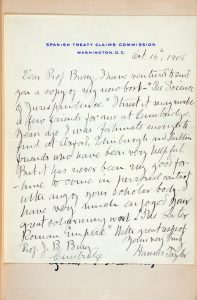 In the first letter (October 14, 1908), Taylor reaches out to J.B. Bury (1861-1927), the Regius Professor of Modern History at Cambridge. Taylor writes, “I have ventured to give you a copy of my new book – “The Science of Jurisprudence.” I trust it may make a few friends for me at Cambridge.” We do not have Bury’s response. However, Taylor’s second letter (November 25, 1908) quotes extensively from it.
In the first letter (October 14, 1908), Taylor reaches out to J.B. Bury (1861-1927), the Regius Professor of Modern History at Cambridge. Taylor writes, “I have ventured to give you a copy of my new book – “The Science of Jurisprudence.” I trust it may make a few friends for me at Cambridge.” We do not have Bury’s response. However, Taylor’s second letter (November 25, 1908) quotes extensively from it.
After acknowledging Bury’s letter, Taylor notes his delight to have Bury say that the book “is a work of the greatest interest to the historian who is not a lawyer,” and volunteers that it is “having a splendid reception at home and abroad.” He goes on to mention praise he has received to the same effect from Joseph H. Choate, who described the book as a revelation. “My friends here,” Taylor writes, “tell me that I have added a new chapter to the history of the American Constitution.”
On one hand, the letters may suggest that Taylor was arrogant and unabashed in his self-promotion. On the other, the letters may suggest something slightly different about Taylor- that he was desperate for validation. In his biography, McWilliams portrays Taylor in this light.
In 1902, after three failed campaigns in Alabama (two for United States Congress and one for president of the University of Alabama), Taylor was dejected and moved his family to Washington D.C. There, he worked tirelessly to establish himself in elite social and political circles. However, despite his prolific publications and social success in Washington, he always seemed to fall short of true prominence. McWilliams offers the story of a particular effort Taylor made to court the favor of Theodore Roosevelt. Aware of the president’s love for hunting, Taylor bought him a mounted moose head. In his rejection of the gift, Roosevelt wrote: “My dear fellow… I simply haven’t the room in my house for another trophy… It was awfully good of you to think of me.” Later, and also without success, Taylor would seek appointments in the administrations of Woodrow Wilson and Warren Harding. McWilliams leaves the impression that, despite his myriad accomplishments, Taylor never felt he had reached the “inner circle” to which he was aspiring. In light of these rejections, it becomes hard to read Taylor’s letters to Bury without a sense of sympathy. Taylor seems to believe that he has finally left the impression for which he has spent his whole life working. Furthermore, his repeated quoting of Bury’s compliments suggests that as hard as Taylor was working to prove his success to those around him, he was working just as hard to prove it to himself.
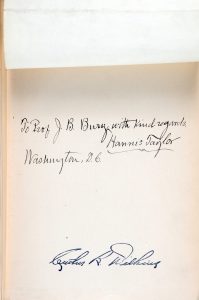
In conjunction with the self-promotion in Taylor’s letters, the subject matter of the The Science of Jurisprudence is interesting. Particularly, it is through his attempt to secure a legacy for Pelatiah Webster that Taylor is attempting to secure a legacy for himself. One cannot help but wonder whether Taylor saw something of himself in the Philadelphia attorney from two hundred years earlier: an (allegedly) great political thinker who never received the credit he was due.
As modern readers, we can impute a sense of dramatic irony to the claims Taylor makes in both his letters and the book: Taylor is no more remembered for contributions to the history of the Constitution than Pelatiah Webster is remembered for contributions to the Constitution itself. However, research on the legacy of The Science of Jurisprudence adds another layer of dramatic irony. Around the same time that Taylor sent The Science of Jurisprudence to Bury, Henry Goudy, another English scholar, published an essay about the book in the Juridical Review. With all of the acerbic wit of a British scholar, Goudy entitled the essay: “Plagiarism – A Fine Art.”
In his essay, Goudy explains that he skimmed the book’s references and noticed sparing citations of John Muirhead’s Historical Introduction to the Law of Rome, a book that Goudy himself edited. “It struck me, on reading Taylor’s chapter [on Roman law],” Goudy adds, “that a number of his sentences had a strangely familiar ring about them.” From there, Goudy accuses Taylor of plagiarism and offers the readers to “judge for themselves” by examining the texts side by side. There are perhaps times when plagiarism claims stem from careless citation errors and accidental similarities. However, by the end of Goudy’s article his allegations become increasingly difficult to dismiss. The side-by-side comparison shows that Taylor apparently copied large sections from other texts, occasionally using different words or slightly varying the sentence structure. In addition, Goudy notes that “occasional mistakes in Muirhead are… copied without attempt at correction.” (Goudy, “Plagiarism,” 303, 304, 310)
One can imagine the embarrassment this article caused Taylor, and we can see a small glimpse of it in a letter Taylor published in the Washington D.C. Evening Star shortly after Goudy’s article surfaced. The tone of Taylor’s comment is one of incredulity. He asks why, if he is guilty of plagiarism, the living authors from whom he stole gave the book nothing but strong praise. In closing, he adds a chilling ad hominem remark, casting Goudy’s public censure as “the malice of one who resents my intrusion into a field which he considers all his own, but to which he has never contributed a single new idea.” (“Mr. Taylor Replies,” Washington, D.C. Evening Star)
Taylor’s own defense of his scholarly integrity is so adamant that the reader wonders whether he even recognized what he did as plagiarism. It also may suggest why other scholars may have been reluctant to question his honesty and thus make themselves the subject of his ire.
The interchange turned into an embittered public correspondence, arguably culminating with an article authored by Roscoe Pound, the soon-to-be Dean of Harvard Law School. In a Law Review note, Pound explains the legal doctrine of accession: by combining different parts that belong to someone else, a person may acquire ownership of the whole. “Evidently,” Pound writes, “Dr. Taylor was proceeding under this doctrine when he published [The Science of Jurisprudence].” (Pound, “Taylor’s Science of Jurisprudence,” 525, 531-532)
It is perhaps impossible to say whether the Webster theory or the plagiarism was ultimately more damning to Taylor’s career. The effects of both can be seen in writings from several years later, when Taylor voiced another bold opinion at the beginning of the first World War. Though he supported the war effort, Taylor felt that the government did not have the constitutional authority to send the national militia overseas, a position he argued before the Supreme Court in 1918, in Cox v. Wood. (247 U.S. 3) Like the Webster claim, this argument was highly unpopular. Unlike the Webster claim, this unpopular argument seemed to have merit. McWilliams lauds Taylor’s carefully researched brief and calls it Taylor’s most significant effort as an attorney.
Nevertheless, Taylor’s notoriety seemed to precede him into the courtroom. Letters reflect that Oliver Wendell Holmes in particular had long scorned Taylor, writing a year earlier that he did not believe Taylor to be “capable of unplagiarized merit.” (Holmes-Laski Letters, 46) Furthermore, during Taylor’s oral argument, Holmes apparently whispered to Justice Van Devanter, “I do despise a martyr. He is a pigheaded adherent of an inadequate idea.” One might ask whether Holmes was referring to the case at hand or Taylor’s Webster theory. Indeed, in a letter to the justice sometime before, Harold Laski wrote of Taylor, “that Pelatiah Webster myth has prejudiced me greatly against him,” to which Holmes replied, “H. Taylor I think of as you do.” (Holmes-Laski Letters, 47, 49)
In any event the other Justices were apparently of one accord with Holmes; the Cox decision was unanimous in favor of the Government. If Science of Jurisprudence predisposed the Court against him, there is no one to blame but Taylor himself. Still, the case illustrates Taylor’s willingness to doggedly fight for an unpopular cause. The merit of Taylor’s argument in Cox raises the specter of a commendable reputation that he might have rightly earned in different circumstances.
Perhaps ironically, the most recent scholarship on Taylor is an interesting and thorough account of the Goudy-Taylor exchange by a professor at the University of Edinburgh. Professor John W. Cairns’ 2015 depiction of Taylor shares the same caustic tone as Goudy’s. In Cairns’ assessment, Taylor was a charlatan who trampled over the efforts of earlier scholars in an attempt to make a name for himself. Goudy, he suggests, was a justice-seeking scholar brave and selfless enough to make a point of Taylor’s dishonesty. (Cairns, “Henry Goudy, Hannis Taylor, and Plagiarism,” 90, 91)
To the credit of Cairns’ assessment, Goudy himself wrote that his public scrutiny of Taylor was motivated by selfless reasons. Had it just concerned him, Goudy claims that “he probably would have kept silence.” However, he adds, “the duty which I owe to my deceased master and friend compels me to write.” Goudy notes that though Muirhead received “no great recognition” for his “unremitting toil,” “his writings were his own, and one must see that they are not wrongfully appropriated by others after his death.” (Goudy, “Plagiarism,” 315)
Whether Goudy was truly motivated by devotion to his mentor or a sense of personal justice will never be known. However, it is interesting to see the theme of legacy emerge in Goudy’s article. Perhaps legacy is the common thread that ties all of these stories together: Taylor sought to create his own legacy by asserting the legacy of Pelatiah Webster. Goudy sought to protect the legacy of his mentor by publicly challenging Taylor’s integrity. Cairns, interestingly enough, devotes the last section of his article to memorializing Goudy’s scholarship and character (closing with the sentence: “It is good that a man of his principles, kindness, and integrity, was remembered”). (Cairns, “Henry Goudy, Hannis Taylor, and Plagiarism,” 99)
It may be the theme of “legacy” that leads this student to feel more compassion for Taylor than Cairns and Goudy seem to offer him: it is nearly impossible to look at Taylor without seeing something of ones’ self. Who, after all, doesn’t want to be validated, appreciated, and remembered? Who doesn’t at least occasionally fear that his or her efforts will be overlooked? But if Taylor’s plight is sympathetic, our glimpse of him also may provide a cautionary tale—that the plagiarism is only an example of what Taylor was willing to do because of his obsessive determination to leave a legacy.
McWilliams offers a particularly harrowing example on the last page of his biography: in a Christmas Eve tradition, Taylor would gather the family around and have one of the children read from his newspaper clippings. With his progeny gathered around him, all he could think about were the achievements of his past.
Works Cited:
John W. Cairns, “Henry Goudy, Hannis Taylor, and Plagiarism Considered as a Fine
Art,” 30 Tulane European & Civil Law Forum 1, 1-79 (2015).
Edward S. Corwin, “The Pelatiah Webster Myth,” 10 Michigan Law Review 619 (1912).
Henry Goudy, “Plagiarism—A Fine Art,” 20 Juridical Review 302 (1908-1909).
Oliver Wendell Holmes, The Holmes-Laski Letters: The Correspondence of Mr. Justice Holmes and Harold J. Laski, 1916-1935. Edited by Mark De Wolfe Howe. Cambridge: Harvard University Press, 1953.
Tennant McWilliams, Hannis Taylor: The New Southerner As an American. University, Alabama: University of Alabama Press, 1978.
Roscoe Pound, “Taylor’s Science of Jurisprudence—A Literary Application of the Doctrine of Accession,” 3 Illinois Law Review 525-533 (1909).
Letter from Hannis Taylor to the Editor, “Mr. Taylor Replies. Meets Dr. Goudy’s Charge of Plagiarism,” Washington, D.C. Evening Star, January 28, 1909.
Hannis Taylor, The Origin and Growth of the English Constitution, 2 Vols. Boston: Houghton Mifflin Co., 1889, 1898.
Hannis Taylor, The Science of Jurisprudence, New York: Macmillan Co., 1908

